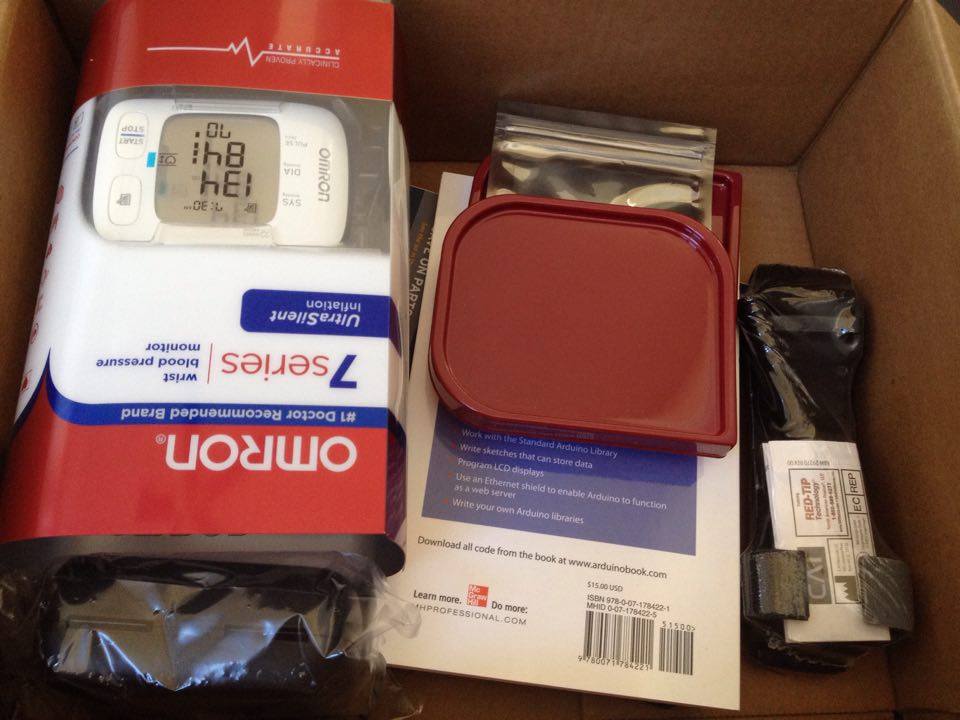First Update from the TJHSST InvenTeam—Season's Greetings!
Hello, world!
It's been a while since our last blog—because we haven't blogged at all this year. Oops. We promise to keep you all updated in the coming months. In any case, here's a lengthy update on our progress.
For those of you unfamiliar with our project, we essentially strive to create a new automated emergency tourniquet which is easier to use and would be more accessible to those untrained in medical response. Our device will be effective, convenient, and especially intuitive to use. Right now, we plan to engineer an Arduino microcontroller connected to a tourniquet cuff and pressure regulator. This microcontroller would also communicate with the operator of the device. Think of something like an AED, except for tourniquets.
As of now, we are still in the design phase. Just last week, our preliminary materials arrived: a blood pressure monitor, an Arduino pulse sensor, a military issue tourniquet, and Arduino books. These items, combined with the materials we already have, will allow us to design the infrastructure of the device—the basic construction of how the Arduino will interface with the pulse detection, which is arguably the most difficult part of the device to design. For our next purchase, we're looking to purchase cuffs so that we can work on the interfacing between the Arduino board and the cuff's tightening mechanisms. We are excited to start building and prototyping soon!

We've also been hard at work making sure we have a strong foundation in modern tourniquet technology and a deep understanding of our project's goals before we start building. To this end, we have been continuously meeting with technical experts.
Mr. Barry Potoker, a navy reserve member, talked to us about modern tourniquet designs used on the battlefront. We looked at a Combat Application Tourniquet (C-A-T), which is a manual tourniquet used by soldiers. The device is applied above a wound, tightened with extreme force until blood stops flowing, and then disposed of after the wound is treated. He also mentioned that some soldiers may even walk around with tourniquets readily-available; thus, the weight of the device is an extremely important aspect. After our meeting, we considered how the device could be improved with regards to usability, especially since the C-A-T isn't intuitively usable at first glance. We also thought about how to minimize the device's weight while integrating all parts of an automatic device, including the Arduino board. We revised our device specifications to account for this.
Dr. James McEwen, inventor of the original automatic tourniquet, talked to us about the feasibility of using an electric motor to control the constriction mechanism of the cuff in lieu of using gas. He advised against using a motor, because it is riskier than gas control with regards to damaging nervous tissue. Dr. McEwen also provided us with a link to a review of modern automatic tourniquet technology, which gives guidelines for optimal limb occlusion pressure compared to cuff size, and gives data on cuff width relating to applied pressure. These guidelines will be used in our Arduino board's software to calculate how much pressure is applied by the cuff.
Captain Justin Scott conferred with us about the application of tourniquets in emergency care. He talked about a few concerns he had with preexisting tourniquets: 1. Blood cakes down velcro on cuffs and makes the device slippery. We decided that we should have some waterproofing applied to our microcontroller and electronics, and should refrain from placing velcro on keystone parts; 2. Camouflage can make tourniquets hard to see, which is actually a bad thing since emergency responders need to see if a tourniquet has already been applied. Therefore, we should consider coloring our device black; 3. Testing can be very expensive. Thankfully, Captain Scott was very generous in lending us access to testing equipment. With these notes in mind, we have a clearer view on how to design our final device.
With college application season nearing its end, our InvenTeam will prioritize prototyping the device in the coming weeks. We've made headway into designing the device, and have met with some amazing people to talk about our project. In the future, we will continue to work on the various components of the device, culminating in our actual construction of the automatic emergency tourniquet. For now, though, 'tis the season to celebrate the holidays. We'll keep you updated on our progress in 2016!
The TJHSST InvenTeam,
Ms. Ria Galanos, Bijal, Bill, Dhriti, Gabriel, Jonathan, Junyoung, Lavanya

